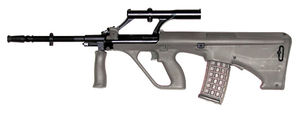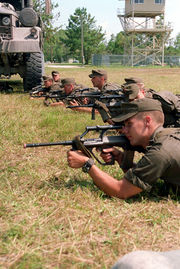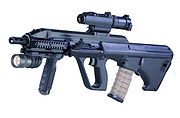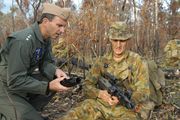Steyr AUG
| Steyr AUG | |
|---|---|
 Steyr AUG A1 with 508 mm (20.0 in) barrel |
|
| Type | Assault rifle |
| Place of origin | |
| Service history | |
| In service | 1979–present [1] |
| Used by | See Users |
| Wars | |
| Production history | |
| Designer | Horst Wesp, Karl Wagner, Karl Möser |
| Designed | 1977 |
| Manufacturer |
|
| Produced | |
| Variants | See Variants |
| Specifications | |
| Weight | |
| Length | |
| Barrel length | |
|
|
|
| Cartridge |
|
| Action | Gas-operated, rotating bolt |
| Rate of fire | 650-700 rounds/min [1] |
| Muzzle velocity | Standard rifle: 940 m/s (3,084 ft/s) |
| Effective range | Sighted for 300 m (450-500m) |
| Feed system | |
| Sights | Swarovski 1.5x telescopic sight, back-up iron sights |
The AUG is an Austrian bullpup 5.56mm assault rifle, designed in the early 1970s by Steyr Mannlicher GmbH & Co KG (formerly Steyr-Daimler-Puch). The AUG (Armee Universal Gewehr—"universal army rifle") was adopted by the Austrian Army as the StG 77 (Sturmgewehr 77) in 1977,[2] where it replaced the 7.62mm StG 58 automatic rifle (a license-built FN FAL).[3] In production since 1978, it is the standard small arm of the Austrian Bundesheer and various national police units.
The rifle has also been adopted by the armed forces of Argentina, Australia (accepted into service in 1985 and manufactured by Australian Defence Industries in Lithgow, this Austeyr model is also in use by New Zealand), Bolivia, Ecuador (since 1988), Republic of Ireland, Luxembourg, Saudi Arabia, Tunisia (introduced in 1978), Pakistan, and (since 1988) U.S. Customs (now the U.S. Immigration and Customs Enforcement agency).
Contents |
Design details

The AUG, a bullpup 5.56mm assault rifle, is a selective fire weapon with a conventional gas piston operated action that fires from a closed bolt.[4] Designed as a family of rifles that could be quickly adapted to a wide variety of roles with the change of the barrel to a desired length and profile, the AUG is a modular configuration rifle that employs a high level of polymer and advanced alloy components.
The primary variant of the rifle, designated the AUG A1, consists of six main assemblies: the barrel, receiver with integrated telescopic sight, bolt and carrier, trigger mechanism, stock and magazine.[4]
The AUG uses the 5.56x45mm NATO cartridge and the standard 1:9 rifling twist will stabilize both SS109/M855 and M193 bullets. Some nations including Australia and New Zealand use a version with a 1:7 twist optimised for the SS109 NATO round.
Features
The rifle features a two-stage trigger (pulling the trigger halfway produces semi-automatic fire, pulling the trigger all the way to the rear produces fully automatic fire) and a safety mechanism (cross-bolt, button type), located immediately above the hand grip.[4] In its “safe” position (white dot) the trigger is mechanically disabled; pressing the safety button to the left exposes a red dot and indicates the weapon is ready to fire. Some versions have an ALO or "automatic lockout", a small projection at the base of the trigger. This was first included on the Irish Defence Forces variant of the rifle, and soon after, the Australian Defence Forces variant. In the exposed position the ALO stops the trigger being squeezed past the semi-automatic position. If needed, the ALO can be pushed up to permit automatic fire.[5]
The rifle is fed from translucent, double-column box magazines (molded from a high-strength polymer) with a 30-round capacity and an empty weight of 130 g (4.6 oz). The light machine gun version of the AUG uses an extended 42-round magazine.
Integrated with the receiver casting is a fixed carry handle that contains a 1.5x telescopic sight made by Swarovski Optik.[4] It contains a simple black ring reticle with a basic rangefinder that is designed so that at 300 m (984.3 ft) a 180 cm (5 ft 10.9 in) tall man-size target will completely fill (subtend) it, giving the shooter a relatively accurate method of estimating range. The sight cannot be set to a specific range but can be adjusted for windage and elevation for an initial zero and is designed to be calibrated for 300 m. When so set, aiming at the centre of a target will produce a hit at all ranges out to 300m. The rifle also has a back-up iron sight with a rear notch and front blade, cast into the top of the aluminum optical sight housing, used in case of failure or damage to the primary optical sight. The sight is also equipped with a set of three illuminated dots (one on the front blade and two at the rear) for use in low-level lighting conditions. In order to mount a wide range of optics and accessories, a receiver with a NATO-standard Picatinny rail and detachable carry handle was also developed and introduced in 1997.
Three-pronged, open-type flash suppressors were used on the 350 mm (13.8 in), 407 mm (16.0 in) and 508 mm (20.0 in) length barrels, whereas the 621 mm (24.4 in) light machine gun barrel received a closed-type ported muzzle device (combination flash suppressor and compensator) and an integral, lightweight folding bipod. The flash suppressors are screwed to the muzzle and internally threaded to take a blank-firing attachment.
The rifle comes standard with four magazines, a muzzle cap, spare bolt for left-handed shooters, blank-firing adaptor, cleaning kit, sling and either an American M7 or German KCB-77 M1 bayonet.
Modularity
The rifle is fully ambidextrous.[4] It can be configured for use by left-handed shooters by simply changing the bolt for a left-handed one with the extractor and ejector on opposite sides, and moving a blanking cap from the left ejection opening to the right.

Variants include a compact 350 mm (13.8 in) barrel, 407 mm (16.0 in) carbine barrel, 508 mm (20.0 in) standard rifle-length barrel and a 621 mm (24.4 in) light machine gun barrel.[4]
Rifles equipped with 407 mm (16.0 in) and 508 mm (20.0 in) barrels are able to launch rifle grenades. 508 mm (20.0 in) pattern barrels produced for military purposes are also equipped with a bayonet lug. The manufacturer offers two other 508 mm (20.0 in) barrel configurations: the first – fitted with a fixed, post foresight (used on the standard rifle version with aperture iron sights) and the second type – equipped with a 40 mm M203 grenade launcher that can be used mounted on the standard length rifle or autonomously – as a stand-alone grenade launcher after attaching a shoulder pad to the end of the 5.56 mm barrel.
Operating mechanism
The rotating bolt features 7 radial locking lugs and is unlocked by means of a pin on the bolt body and a recessed camming guide machined into the bolt carrier. The bolt carrier itself is guided by two guide rods brazed to it and these rods run inside steel bearings in the receiver. The guide rods are hollow and contain the return springs. The bolt also contains a claw extractor that forms the eighth locking lug and a spring-loaded "bump"-type casing ejector.
The gas cylinder is offset to the right side of the barrel and works with one of the two guide rods. The AUG uses a short-stroke piston system where the right guide rod serves as the action rod, transmitting the rearward motion of the gas-driven piston to the bolt carrier. The left-hand rod provides retracting handle pressure when connected by the forward assist and can also be used to remove fouling in the gas cylinder by utilizing the left-hand guide rod as a reamer. The firearm uses a 3-position gas valve. The first setting, marked with a small dot, is used for normal operation. The second setting, illustrated with a large dot, indicates fouled conditions. The third, "GR" closed position is used to launch rifle grenades (of the non-bullet trap type).
The AUG is hammer-fired and the firing mechanism is contained in the rear of the stock, near the butt, covered by a synthetic rubber shoulder plate. The hammer group is made entirely of plastics except for the springs and pins and is contained in an open-topped plastic box which lies between the magazine and the buttplate. During firing the recoiling bolt group travels over the top of it, resetting the hammer. Since the trigger is located some distance away, it transmits its energy through a sear lever which passes by the side of the magazine. The firing pin is operated by a plastic hammer under pressure from a coil spring.
Engineering
The quick-change barrel used in the AUG is cold hammer-forged by GFM-GmbH of Steyr Austria for increased precision and durability, its bore, chamber and certain components of the gas system are chrome-plated. The standard rifle-length barrel features 6 right-hand grooves and a rifling twist rate of 228 mm (1:9 in). An external sleeve is shrunk on to the barrel and carries the gas port and cylinder, gas valve and forward grip hinge jaw. There is a short cylinder which contains a piston and its associated return spring. The barrel locks into a steel insert inside the receiver through a system of eight lugs arranged around the chamber end and is equipped with a folding, vertical grip that helps to pivot and withdraw the barrel during barrel changes. The most compact of the barrels has a fixed vertical grip.
The receiver housing is a steel-reinforced aluminum extrusion finished with a baked enamel coating.[4] It holds the steel bearings for the barrel lugs and the guide rods. The non-reciprocating plastic cocking handle works in a slot on the left side of the receiver and is connected with the bolt carrier's left guide rod. The cocking handle has a forward assist feature – alternatively called a "silent cocking device" – used for pushing the bolt shut without recocking the rifle.[4][6] A bolt hold-open device locks the bolt carrier assembly back after the last round has been fired.[6] The AUG lacks a bolt release button, and the cocking handle must be retracted to release the bolt group after a new magazine has been inserted.
The rifle’s stock is made from fiberglass-reinforced polyamide 66. At the forward end is the pistol grip with an enlarged forward trigger guard completely enclosing the firing hand that allows the rifle to be operated with winter gloves.[4] The trigger is hung permanently on the pistol grip, together with its two operating rods which run in guides past the magazine housing. Behind that is the locking catch for the stock group. Pressing this to the right will separate the receiver and stock. The magazine catch is behind the housing, on the underside of the stock. Above the housing are the two ejector openings, one of which is always covered by a removable strip of plastic. The rear of the stock forms the actual shoulder rest which contains the hammer unit and the end of the bolt path. The butt is closed by an endplate which is held in place by the rear sling swivel. This swivel is attached to a pin which pushes in across the butt and secures the plate.
Variants
A semi-automatic version of the rifle known as the AUG P is available to the civilian and law enforcement markets. It features a shorter, 407 mm (16.0 in) barrel and a modified bolt, carrier and trigger assembly that will only allow semi-automatic fire. The rifle also has a slightly different optical sight that features a reticule with a fine dot in the center of the aiming circle, allowing for more precise aiming.
The light machine gun variant can be modified to fire from an open bolt (called the AUG LMG in this configuration). To accomplish this, a modified bolt carrier, striker and trigger mechanism with sear are used.
Based on the AUG, Steyr developed the 9 mm AUG submachine gun that fires the 9x19mm Parabellum pistol cartridge. It is an automatic, blowback-operated model that fires from a closed bolt. Unlike the rifle variants, this SMG has a unique 420 mm (16.5 in) barrel with 6 right-hand grooves at a 250 mm (1:9.8 in) rifling twist rate, ended with a recoil compensator, a slightly different charging handle and a magazine well conversion insert enabling the use of standard 25-round box magazines from the Steyr MPi 81 and TMP submachine guns. A conversion kit used to transform any rifle variant into the submachine gun is also available. It consists of a barrel, bolt, adapter insert and magazine.




- AUG A1: Standard version introduced in 1977. Available with a choice of olive or black furniture.[7]
- AUG A2: Similar to the AUG A1, but features a redesigned charging handle and a detachable telescopic sight which can be replaced with a MIL-STD-1913 rail.[7]
- AUG A3: Similar to the AUG A2, but features a MIL-STD-1913 rail on top of the receiver, and an external bolt release.[8]
- AUG A3 SF (also known as the AUG A2 Commando): Similar to the AUG A2, but features MIL-STD-1913 rails mounted on the telescopic sight and on the right side of the receiver, and includes an external bolt release.[9] It was adopted by the Austrian Special Forces in late 2007.[10]
- AUG A3 SA USA: Semi-automatic AUG A3 with a 407 mm (16.0 in) barrel, made available for the U.S. civilian market in April 2009.[11][12]
- AUG P: Semi-automatic AUG A1 with a shorter, 407 mm (16.0 in) barrel.
- AUG P Special Receiver: Similar to the AUG P, but features a MIL-STD-1913 rail on top of the receiver.
- AUG 9mm (also known as the AUG SMG or AUG Para): Chambered in 9x19mm Parabellum and produced since 1988.[1] Differs from A1 model in barrel, bolt, magazine and a magazine well adapter, which allows the rifle to feed from Steyr MPi 69 magazines. This version operates as a blowback firearm, without use of the rifle's gas system.[13] For some time a kit of the above components was available to convert any AUG into a 9mm variant.[14]
- AUG A3 9mm XS: 9mm version of the AUG A3, similar to the AUG 9mm. Features a 325 mm (12.8 in) barrel and Picatinny rail system.[15]
- AUG M203: An AUG modified for use with the M203 grenade launcher.
- AUG LSW (Light Support Weapon): A family of light support versions of the AUG.
- AUG HBAR (Heavy-Barreled Automatic Rifle): A longer, heavier-barreled version for use as a light machine gun.
- AUG LMG (Light machine gun): Based on the AUG HBAR, fires from an open bolt, has 4x rather than 1.5x optic of the base AUG.
- AUG LMG–T: Same as LMG, but has rail similar to the AUG P Special Receiver.
- AUG HBAR–T: A designated marksman rifle based on the HBAR with a universal scope mount cast into the receiver and fitted with a Kahles ZF69 6x42 optical sight.
- AUG Z: Semi-automatic version, somewhat similar to the A2, intended primarily for civilian use.
- AUG SA: Semi-automatic version of the A1 variant; built for civilian use and import to the US before being banned from importation in 1989.
- USR: An AUG A2 modified to meet U.S. BATF regulations, with modifications including a thumbhole grip.[16] All rifles were imported by GSI.[16]
American Clones of the Steyr AUG
- MSAR STG-556: Introduced at the 2007 SHOT Show, the MSAR STG-556 is manufactured by Microtech Small Arms Research Inc. (a subsidiary of Microtech Knives) and is an AUG A1 clone significantly re-engineered in its working system and principle as it features a bolt hold-open device as seen on the M16 rifle; otherwise the MSAR STG-556 retains the original AUG features, such as feeding from proprietary translucent plastic magazines and having the quick-change barrel option. The STG-556 rifle can be converted from either having a telescopic sight or a MIL-STD-1913 rail. It is available in either civilian (semi-automatic only) and military/law enforcement (selective fire) variants.[6][17]
- TPD USA AXR: Revealed at the 2007 SHOT Show, manufactured by Tactical Products Design Inc. as an AUG A2 clone capable of semi-automatic only fire, aimed for both the civilian and law enforcement markets, and fed by STANAG magazines; the manufacturer sells clear plastic magazines which are STANAG 4179 compliant and will readily fit in any rifle with a compatible magazine catch.[18] The rifle does not have the integral scope, allowing users to use any kind of scopes or laser sights on the Picatinny railing.[19]
Australian
- F88 Austeyr: The Australian Army's modified version of the Steyr AUG A1. Changes for the Australian version include a bayonet lug, a 1:7 in rifling pitch as found in the M16A2 rifle, optimized for the heavier 62-grain NATO-standard SS109/M855 round and an "automatic lockout" selector that can physically disable the fully automatic position of the 2-stage trigger mechanism found on the standard AUG. Contrary to popular belief the Australian issued F88 does not have the crosshair inside the "doughnut", however the New Zealand issued AUG does incorporate this feature. The AUG won a competition against the prototype of what would become the Bushmaster M17S. The components are built under license at the Australian Defence Industries factory in Lithgow, New South Wales (now known as Thales Australia).[20]
- F88C Austeyr: A carbine version of the Austeyr F88 featuring a shorter, 407 mm (16.0 in) barrel. The F88C is generally used as a personal defensive weapon where maneuverability is an issue, such as in armoured vehicles.
- F88S Austeyr: A version of the Australian Austeyr F88 with an integrated Picatinny rail in place of the standard optical sight that allows the attachment of various other sighting devices (night vision scopes, magnified and non-magnified optics such as the ELCAN C79, Trijicon ACOG or Aimpoint).
- F88S-A1C: The Austeyr F88S-A1C is a compact variant of the F88 fitted with a Picatinny rail. The rifle has a 407 mm (16.0 in) barrel. Typically issued to front-line combat infantry units with room and weight constraints such as cavalry, reconnaissance, light horse, paratroopers and airfield defense guards (RAAF).

- F88 GLA: Australian Army version with an M203 grenade launcher. It features an Inter-bar (armourer attached) interface, an RM Equipment M203PI grenade launcher, and a Knight's Armament quadrant sight assembly to which a Firepoint red dot sight is attached. The bayonet lug and forward vertical grip are not present in this model.
- F88T: ADI has developed a .22-caliber training rifle for use by the Australian Army. The rifle provides an economical training alternative, with very low ammunition cost, which can be used in environmentally sensitive training areas and ranges where "overshooting" is an issue, and there is less of a chance to injure instructors and other persons.[20]
- Austeyr F88A4: ADI's proposed F88A4 will incorporate multiple Picatinny rails for the fitting of legacy systems such as the M203P1 40 mm grenade launcher as well as both commercial off-the-shelf (COTS) and military off-the-shelf (MOTS) sighting and battle enhancement accessories. Also, it must be noted that the A4 has only been bought in limited numbers (reportedly only 10 units) for evaluation purposes.
- DSTO Advanced Individual Combat Weapon: Experimental weapon combining the barrel, action and magazine of a Austeyr F88 with an enlarged receiver and stock/body that also incorporates a multiple-shot 40 mm grenade launcher.
Users



 Argentina: Argentine Armed Forces.[21]
Argentina: Argentine Armed Forces.[21] Australia: Entered service in 1989 as the new issue weapon of the Australian Defence Force.[22] The first regular unit to be issued with the F88 was 6RAR, who received them in January 1989. Rifles are built locally by Australian Defence Industries under license from Steyr Mannlicher.[23]
Australia: Entered service in 1989 as the new issue weapon of the Australian Defence Force.[22] The first regular unit to be issued with the F88 was 6RAR, who received them in January 1989. Rifles are built locally by Australian Defence Industries under license from Steyr Mannlicher.[23] Austria: Standard service weapon of the Bundesheer, serving as the StG 77 in official army nomenclature.[2] Also used by EKO Cobra.[24]
Austria: Standard service weapon of the Bundesheer, serving as the StG 77 in official army nomenclature.[2] Also used by EKO Cobra.[24] Bolivia[25]
Bolivia[25] Bulgaria: SOBT only.[26]
Bulgaria: SOBT only.[26] Cameroon[25]
Cameroon[25] Djibouti[27]
Djibouti[27] Ecuador[25]
Ecuador[25] Falkland Islands: Falkland Islands Defence Force.[28]
Falkland Islands: Falkland Islands Defence Force.[28] Gambia[25]
Gambia[25] Indonesia: Komando Pasukan Katak (Kopaska) tactical diver group and Komando Pasukan Khusus (Kopassus) special forces group.[29]
Indonesia: Komando Pasukan Katak (Kopaska) tactical diver group and Komando Pasukan Khusus (Kopassus) special forces group.[29] Ireland: Issued to regular and reserve soldiers of the Irish Army since 1988. The Irish Army Rangers use the Steyr AUG A3 and A2.[30][31][32]
Ireland: Issued to regular and reserve soldiers of the Irish Army since 1988. The Irish Army Rangers use the Steyr AUG A3 and A2.[30][31][32] Italy: Carabinieri special forces: Gruppo di Intervento Speciale and 1st "Tuscania" Regiment[33]
Italy: Carabinieri special forces: Gruppo di Intervento Speciale and 1st "Tuscania" Regiment[33] Luxembourg: Standard infantry rifle of the armed forces. The light machine gun version is also employed as the squad support weapon.[34] The Unité Spéciale de la Police intervention unit of the Grand Ducal Police employs the AUG A2 variant.[35]
Luxembourg: Standard infantry rifle of the armed forces. The light machine gun version is also employed as the squad support weapon.[34] The Unité Spéciale de la Police intervention unit of the Grand Ducal Police employs the AUG A2 variant.[35] Malaysia: Made under license from Steyr by SME Ordnance.[36] Local production of the AUG rifle series started in 1991[37] with a joint production with Steyr that started in 2004.[38][39] Lawsuits from Steyr emerged when Malaysia decided to withdraw from joint production.[40]
Malaysia: Made under license from Steyr by SME Ordnance.[36] Local production of the AUG rifle series started in 1991[37] with a joint production with Steyr that started in 2004.[38][39] Lawsuits from Steyr emerged when Malaysia decided to withdraw from joint production.[40] Morocco[25][27]
Morocco[25][27] Netherlands[1]
Netherlands[1] New Zealand: In service since 1988. The first 5,000 weapons delivered were manufactured in Austria by Steyr Daimler Puch. The majority of weapons now in service are the Australian ADI-made Austeyr F88 variant. It is called the IW Steyr (Individual Weapon Steyr) in service of the New Zealand Defence Force.[41]
New Zealand: In service since 1988. The first 5,000 weapons delivered were manufactured in Austria by Steyr Daimler Puch. The majority of weapons now in service are the Australian ADI-made Austeyr F88 variant. It is called the IW Steyr (Individual Weapon Steyr) in service of the New Zealand Defence Force.[41] Oman[25][32]
Oman[25][32] Pakistan: Special Service Group (SSG) of the Pakistan Army.[42]
Pakistan: Special Service Group (SSG) of the Pakistan Army.[42] Papua New Guinea: F88 variant.[25]
Papua New Guinea: F88 variant.[25] Philippines: Used by the Scout Rangers.[43]
Philippines: Used by the Scout Rangers.[43] Saudi Arabia: Delivered in desert tan color furniture.[27][32]
Saudi Arabia: Delivered in desert tan color furniture.[27][32] Taiwan[25][44]
Taiwan[25][44] Tunisia[25][32]
Tunisia[25][32] United States: U.S. Immigration and Customs Enforcement.[45]
United States: U.S. Immigration and Customs Enforcement.[45]
References
- ↑ 1.00 1.01 1.02 1.03 1.04 1.05 1.06 1.07 1.08 1.09 1.10 1.11 1.12 1.13 1.14 Hogg, Ian (2002). Jane's Guns Recognition Guide. Jane's Recognition Guides. Glasgow: Jane's Information Group and Collins Press. ISBN 9780007127603.
- ↑ 2.0 2.1 Österreichs Bundesheer - Waffen und Gerät - Sturmgewehr 77
- ↑ Ezell (1993) p. 223
- ↑ 4.0 4.1 4.2 4.3 4.4 4.5 4.6 4.7 4.8 Ezell(1993) p. 224
- ↑ Manual of the Steyr rifle, Irish Defence Forces
- ↑ 6.0 6.1 6.2 Choat, Chris (March 2008). "Microtech's STG-556 An Exclusive First Look". The Small Arms Review 11 (6): 43–50
- ↑ 7.0 7.1 "Steyr AUG A1 / A2" (PDF). Steyr Mannlicher. http://www.steyr-mannlicher.com/index.php?eID=tx_nawsecuredl&u=0&file=uploads/media/STM_Produktblatt_AUG_A1_A2_press_01.pdf&t=1244185479&hash=0c46aaef884d605a158cc8f071e0d9f9. Retrieved 2009-06-04.
- ↑ "Steyr AUG A3" (PDF). Steyr Mannlicher. http://www.steyr-mannlicher.com/index.php?eID=tx_nawsecuredl&u=0&file=uploads/media/STM_Produktblatt_AUG_A3_press_01.pdf&t=1244186156&hash=03cbd910081364335b9d679102a4ef4e. Retrieved 2009-06-04.
- ↑ "Steyr AUG A3 SF" (PDF). Steyr Mannlicher. http://www.steyr-mannlicher.com/index.php?eID=tx_nawsecuredl&u=0&file=uploads/media/STM_Produktblatt_AUG_A3SF_press_01.pdf&t=1244186187&hash=8af3affc13f53d7bd8ccdafe807c9f75. Retrieved 2009-06-04.
- ↑ Steyr AUG A2 Commando
- ↑ "Steyr AUG/A3 SA USA". Steyr Mannlicher US. Steyr Mannlicher. http://www.steyrarms.com/products/sporting-rifles/steyr-aug-z/. Retrieved 2009-06-04.
- ↑ "Steyr AUG/A3 USA". http://emptormaven.com/2009/10/steyr-auga3-usa/.
- ↑ "Steyr AUG 9mm" (PDF). Steyr Mannlicher. http://www.steyr-mannlicher.com/index.php?eID=tx_nawsecuredl&u=0&file=uploads/media/STM_Produktblatt_AUG_9mm_press_01.pdf&t=1244186229&hash=6cfc561eebb60151883a5ec12f877966. Retrieved 2009-06-04.
- ↑ "AUG 9mm". REMTEK. http://remtek.com/arms/steyr/aug/aug9/aug9mm.htm. Retrieved 2009-06-04.
- ↑ "Steyr AUG A3 9mm XS" (PDF). Steyr Mannlicher. http://www.steyr-mannlicher.com/index.php?eID=tx_nawsecuredl&u=0&file=uploads/media/STM_Produktblatt_AUG_A3_9mm_XS_press_01.pdf&t=1244186274&hash=7702ca358d8b8e6b19431ab9dc7b0c88. Retrieved 2009-06-04.
- ↑ 16.0 16.1 The Steyr USR. Retrieved on October 31, 2008.
- ↑ "MSAR - Microtech Small Arms Research Inc.". Microtech Small Arms Research. http://www.msarinc.com/home.html. Retrieved 2007-10-12.
- ↑ TPD-USA - Tactical Products Design Inc. Retrieved on October 12, 2007.
- ↑ Modern Firearms' TPD AXR Rifle. Retrieved on October 27, 2008.
- ↑ 20.0 20.1 Steyr.
- ↑ http://www.australiandefence.com.au/56D2AD90-F807-11DD-8DFE0050568C22C9
- ↑ "F88 AUSteyr - Army Internet - ARMY". Defence.gov.au. 2009-07-14. http://www.defence.gov.au/ARMY/F88_AUSteyr.asp. Retrieved 2009-11-17.
- ↑ Steyr
- ↑ http://www.bmi.gv.at/cms/BMI_EKO_Cobra/publikationen/files/LawOrder.pdf
- ↑ 25.0 25.1 25.2 25.3 25.4 25.5 25.6 25.7 25.8 Jones, Richard D. Jane's Infantry Weapons 2009/2010. Jane's Information Group; 35 edition (January 27, 2009). ISBN 978-0710628695.
- ↑ Професия - антитерорист. Capital.bg, May 23, 1998
- ↑ 27.0 27.1 27.2 "Steyr Aug Editorial". Remtek.com. http://www.remtek.com/arms/steyr/aug/edit/augsof.htm. Retrieved 2009-11-17.
- ↑ "Special Forces (Land) (Falkland Islands) - Jane’s Amphibious and Special Forces". Janes.com. 2008-09-15. http://www.janes.com/articles/Janes-Amphibious-and-Special-Forces/Special-Forces-Land-Falkland-Islands.html. Retrieved 2009-11-17.
- ↑ "Kopassus & Kopaska - Specijalne Postrojbe Republike Indonezije" (in Croatian). Hrvatski Vojnik Magazine. http://www.hrvatski-vojnik.hr/hrvatski-vojnik/1612007/ind.asp. Retrieved 2010-06-12.
- ↑ Defence Forces - Army Steyr Assault Rifle
- ↑ Steyr AUG (Armee Universal Gewehr - Universal Army Gun).
- ↑ 32.0 32.1 32.2 32.3 "Steyr Mannlicher US: Our History". Steyrarms.com. http://www.steyrarms.com/about/our-history/. Retrieved 2009-11-17.
- ↑ FireArm Training System. "Militaria - Corpi Elite (12)". Inilossum.it. http://www.inilossum.it/militaria12.html. Retrieved 2009-11-17.
- ↑ Lëtzebuerger Arméi - Matériel - Armement
- ↑ "Equipement :: Unité Spéciale de la Police ::". USP.LU. http://www.usp.lu/armement-assault-fr.php. Retrieved 2009-11-17.
- ↑ "SME Ordnance SDN BHD Products & Services". http://www.epicos.com/epicos/extended/malaysia/ordnance/smeordnance_products.html. Retrieved 2010-03-22.
- ↑ Watters, Daniel E. "The 5.56 X 45mm: 1990-1994". The Gun Zone. http://www.thegunzone.com/556dw-10.html. Retrieved 2010-03-22.
- ↑ Watters, Daniel E. "The 5.56 X 45mm: 2004". The Gun Zone. http://www.thegunzone.com/556dw-13.html. Retrieved 2008-06-21.
- ↑ "Austria to shift assault rifle Steyr production to Malaysia". Defence Talk. 2004-04-12. http://www.defencetalk.com/austria-to-shift-assault-rifle-steyr-production-to-malaysia-2791/. Retrieved 2010-03-22.
- ↑ Watters, Daniel E. "The 5.56 X 45mm: 2005". The Gun Zone. http://www.thegunzone.com/556dw-15.html. Retrieved 2010-03-22.
- ↑ NZ Army - Personal Weapons
- ↑ "Pakdef.info — Pakistan Military Consortium: Special Service Group". Saad, S.; Ali, M.; Shabbir, Usman. 1998. http://www.pakdef.info/pakmilitary/army/regiments/ssg.html. Retrieved 2009-08-15.
- ↑ Burgonio, TJ (2003-08-08). "Mutineers Used Hi-Tech Guns Given By US". Philippine Daily Inquirer. GlobalSecurity.org. http://www.globalsecurity.org/org/news/2003/030808-philippines-weapons01.htm.
- ↑ Kemp, Ian (2009). "A New 5.56mm Generation or a Changing of the Guard?". http://asianmilitaryreview.com - Asian Military Review. http://www.asianmilitaryreview.com/upload/200906161450071.pdf. Retrieved 2010-04-18.
- ↑ "Steyr AUG". Rifles n Guns. 2006-12-08. http://www.riflesnguns.com/assault/steyr/aug.
Bibliography
Ezell, Edward (March 1, 1983). Small Arms of the World. New York: Stackpole Books. p. 894. ISBN 9780880296014
External links
- Steyr Mannlicher—military and law enforcement
- Steyr AUG Z operator's manual (PDF)
- REMTEK
- Steyr-AUG.com
- Buddy Hinton Collection
- Modern Firearms
- The Steyr AUG in the Austrian Army
- Overview of the Steyr AUG at YouTube
- Video of operation at YouTube (Japanese)
|
|||||||